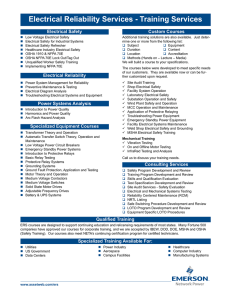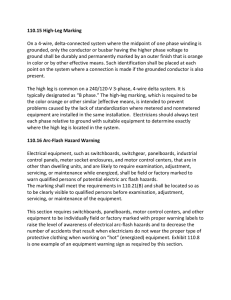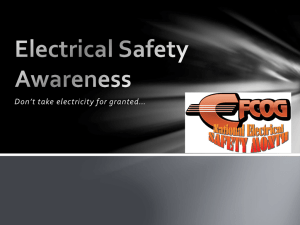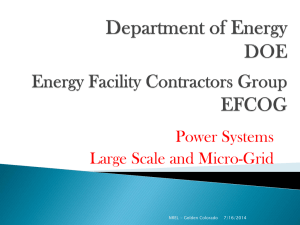NFPA 70E Employer Responsibilities
advertisement
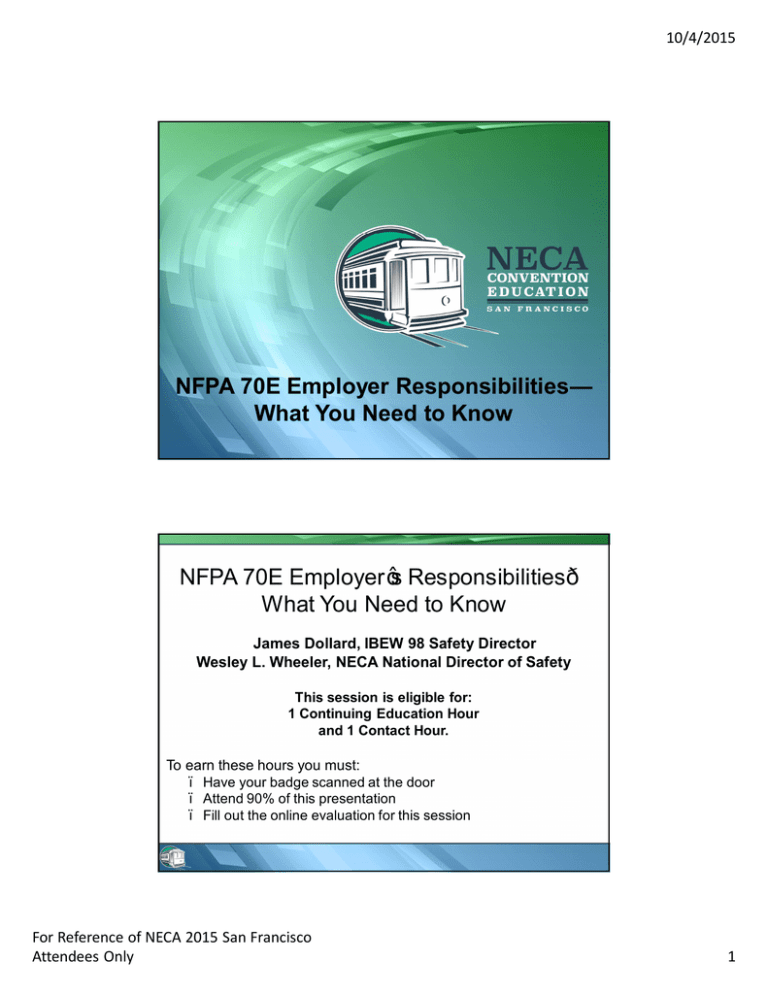
10/4/2015 NFPA 70E Employer Responsibilities— What You Need to Know NFPA 70E Employer’s Responsibilities— What You Need to Know James Dollard, IBEW 98 Safety Director Wesley L. Wheeler, NECA National Director of Safety This session is eligible for: 1 Continuing Education Hour and 1 Contact Hour. To earn these hours you must: – Have your badge scanned at the door – Attend 90% of this presentation – Fill out the online evaluation for this session For Reference of NECA 2015 San Francisco Attendees Only 1 10/4/2015 • How many time has your company been asked by an owner or customer to work on equipment energized? • How many times has an electrician choose to not turn a circuit off because it was an inconvenience? • How many times as a company said yes we can work it hot since our competition won’t do it? For Reference of NECA 2015 San Francisco Attendees Only 2 10/4/2015 • Does pride cause an electrician to take unnecessary risks? • Does production outweigh safety in getting the job done? • Who is going to get the blame if and when something goes wrong? – Owner? – Contractor? – Electrician? • Does OSHA regulations and NFPA requirements only pertain to Electrical Contractors and Electricians? • They apply to anyone performing electrical work. – – – – Electricians HVAC Technicians Maintenance Workers Control Personnel For Reference of NECA 2015 San Francisco Attendees Only 3 10/4/2015 • Is there any electrical contractor, HVAC contractor, plant maintenance worker or plant owner that may not know about NFPA 70E® in todays workplace? oShould they? • Can they plead ignorance as a defense against any citation? • What kind of Personal Protective Equipment should an electrician or electrical worker be familiar with in order to work safely on energized circuits? Objectives • Explain why an employer should take responsibility for following the requirements set forth in NFPA 70E • List three elements of management oversight for NFPA 70E compliance • Identify the information which should be shared between host and contractor • Determine who should sign off on an Energized Electrical Work Permit • Name three audits that must be performed and their frequency For Reference of NECA 2015 San Francisco Attendees Only 4 10/4/2015 Overview Rules Governing Electrical Installation and Safety • National Electrical Code (NEC) • OSHA • NFPA 70E Overview NFPA 70E Compliance • Consensus standard • OSHA General Duty 5(a)(1) • 1910.335(a)(1)(i) For Reference of NECA 2015 San Francisco Attendees Only 5 10/4/2015 Overview Management Oversight and NFPA 70E Requirements: • Establish a policy • Coordinate efforts with host employers • Develop a written electrical safety program • Training including First Aid, CPR and AED • Personal protective equipment/clothing • Maintenance program • Special Equipment • Audit Program NFPA 70E Policy • Express commitment for compliance with NFPA 70E • Make Employees and Prospective Clients/Customers aware of your commitment For Reference of NECA 2015 San Francisco Attendees Only 6 10/4/2015 Host Employer/Customer/Owner • Pre-bid (Estimator, Designer, Owner, etc.) • Determine whether work can be performed de-energized • Provide info to GC/Host/Owner why work must be performed de-energized Host Employer/Customer/Owner Pre-job Meeting • (Project Manager, Site General Foreman, Foreman, Owner, etc.) • Advise host of any unique hazards • Ensure host provides info on known hazards that are existing • Document the meeting For Reference of NECA 2015 San Francisco Attendees Only 7 10/4/2015 Host Employer/Customer/Owner During Work • (Project Manager, Site Foreman, Workers, and/or Owner) • Report any unanticipated hazards found • Identify who to notify if violations observed • Report actions taken to prevent future violations Written Electrical Safety Program Electrical Safety Program • Purpose/Scope • Awareness and Self-Discipline • Principles • Controls • Procedures • Hazard Identification and Risk Assessment Procedures • Job Briefing Procedures For Reference of NECA 2015 San Francisco Attendees Only 8 10/4/2015 Written Electrical Safety Program Energized Work Permit • Description of circuit/equipment and location • Justification for working energized • Safe work practices to be used • Shock and Arc Flash Risk Assessments • Procedures to keep unqualified persons out of work area • Documentation of job briefing • Authorization for working energized Written Electrical Safety Program LOTO • Purpose • Training and Responsibilities • Preparation for Lockout (Tagout) • Lockout (Tagout) Steps • Removal of LOTO • Special Procedures • Discipline • Equipment • Audit For Reference of NECA 2015 San Francisco Attendees Only 9 10/4/2015 Training • Ensure training – Classroom – On-the-job – Combination of both – First Aid, CPR and AED – Annually trained • Demonstrates proficiency • Qualified vs unqualified Training Qualified • Special precautionary techniques; PPE; insulating/shielding materials; insulated tools and test equipment • First aid and emergency procedures • Skills to determine voltage • Approach distances • Selection, use and limitations of voltage detector • How to determine hazards, PPE and procedures to work safely • Skills to identify exposed energized parts • Methods to release victims from energized parts. For Reference of NECA 2015 San Francisco Attendees Only 10 10/4/2015 Training Unqualified § Electrical safety-related practices necessary for their safety § If exposed to shock hazards: o Methods to release victims from energized parts o First aid and emergency procedures Training Retraining • Annual review indicates it • New technology, equipment, or procedures • Procedures not normally used • Intervals not to exceed three years • Annual refresher on CPR and AED Training Documentation • • • • May be electronic or hard copy Content Employee’s name Dates For Reference of NECA 2015 San Francisco Attendees Only 11 10/4/2015 Equipment/PPE/Clothing • Establish a unified commitment for using equipment PPE and protective clothing • Ensure adequate funding is available for equipment and clothing needed. • Make sure the employees use the protection suitable to the hazard level Equipment/PPE/Clothing • Determine level of protection – Shock Risk Assessment § Table 130.4(D)(a) § Table 130.4(D)(b) – Arc Flash Risk Assessment § Incident Energy Calculations “OR” § Table 130.7(C)(15)(A)(a) and Table 130.7(C)(15)(A)(b) and Table 130.7(C)(15)(b) • Ensure use For Reference of NECA 2015 San Francisco Attendees Only 12 10/4/2015 Maintenance and Special Equipment Maintenance • OSHA Regulations • ASTM Standards • Procedures in the absence of host maintenance records • Manufacturers Recommendations and Requirements Maintenance and Special Equipment Special Equipment • Proper training and supervision • Properly installed equipment • Proper access to equipment • Availability of correct tools • Proper identification and guarding • Provision of complete/accurate circuit diagrams • Maintenance areas around equipment • Provision of adequate illumination For Reference of NECA 2015 San Francisco Attendees Only 13 10/4/2015 Audits • Determine employee compliance annually • Audit LOTO annually • Verify written program principles and procedures compliance every three years. Summary • • • • • • • • NFPA 70E Policy Host/Employer Responsibilities Written Program Training PPE and other Protective Equipment Maintenance Special Equipment Audit For Reference of NECA 2015 San Francisco Attendees Only 14 10/4/2015 NFPA 70E Contractor (Employer) Responsibilities – Review Questions 1. Which of the following best describes the rationale for complying with NFPA 70E? a) NFPA 70E is an OSHA requirement b) NFPA 70E offers the only way to protect employees from electrical hazards c) NFPA 70E offers procedures agreed upon by industry to protect employees d) All of the above NFPA 70E Contractor (Employer) Responsibilities – Review Questions 2. Which of the following is an area management should provide oversight? a) Establish a policy for compliance with NFPA 70E b) Review written programs to make sure it addresses NFPA 70E compliance c) Ensure NFPA 70E training is provided by the company or another source such as a consultant d) All of the above For Reference of NECA 2015 San Francisco Attendees Only 15 10/4/2015 NFPA 70E Contractor (Employer) Responsibilities – Review Questions 3. Per NFPA 70E host employers are required to report contractor employee violations to: a) Contractor employer b) OSHA c) Contractor employer and OSHA d) Neither NFPA 70E Contractor (Employer) Responsibilities – Review Questions 4. Who should sign off on an Energized Work Permit? a) The qualified employee performing work b) The supervisor c) Host employer d) All liable parties For Reference of NECA 2015 San Francisco Attendees Only 16 10/4/2015 NFPA 70E Contractor (Employer) Responsibilities – Review Questions 5. What is the frequency set by NFPA 70E for performing an audit of qualified persons working in your employ? a) Every 1 year b) Every 3 years c) Every 5 years d) Never Questions? Don’t forget… • 10:15 -11:30 am Opening General Session • 11:30 am-5:00 pm NECA Show Hours For Reference of NECA 2015 San Francisco Attendees Only 17

